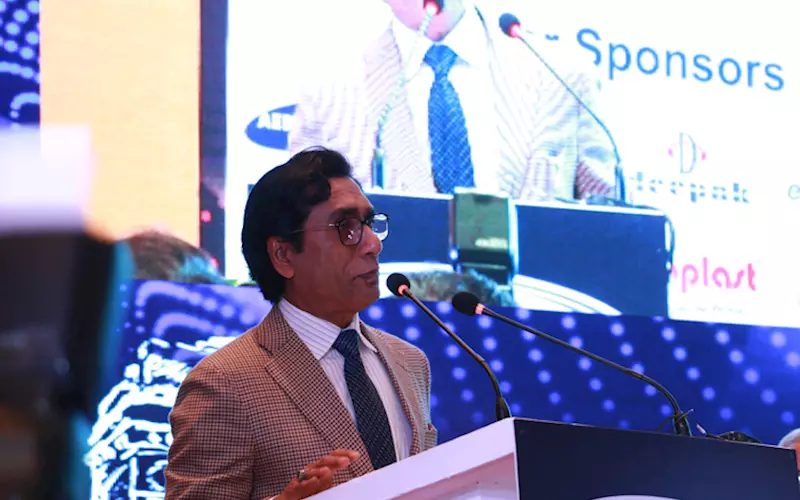Ashok Chaturvedi: ‘Our goal is to have a process for effective waste management’
In a bid to promote recycling of plastic-based packaging waste, Uflex has commissioned a pyrolysis plant at its packaging division in Noida. Pyrolysis is the thermal decomposition of materials at elevated temperatures in an inert atmosphere. It involves the change of chemical composition and is irreversible.
The company highlighted the potential of the pyrolysis plant during Indiaplast 2019, held at India Expo Centre, Greater Noida, from 28 February to 4 March. Rahul Kumar spoke to Ashok Chaturvedi, CMD, Uflex, in the sidelines.
04 Mar 2019 | By Rahul Kumar
Rahul Kumar (RK): You have set up the first pyrolysis process plant in north India. What is the objective?
Ashok Chaturvedi (AC): It is the first-ever pyrolysis process plant in north India, which has been set up at a cost of Rs five crore. The plant will not only protect the environment by converting plastic waste into energy but also nurture a healthier tomorrow. At the plant, we convert about six tonnes of discarded waste material generated every day from printing, unused trim, laminates, tubes and other unprocessed material into liquid fuel, hydrocarbon gas and carbon black which is further utilised in the manufacturing processes. At our Noida plant, we consume a nearly one-lakh litre of fuel daily to run its generators, industrial boilers and furnaces.
The new pyrolysis plant generates nearly 2,000 litres of fuel daily. This is a small gain. But our primary goal is to have a process in place for effective management of the waste that otherwise cannot be recycled.
RK: Please explain the technology.
AC: In this process, the polymer waste stored in the raw material facility is taken to a shredder, cut into smaller pieces and then fed into an air-lock feeding system. The waste material is chemically decomposed at elevated temperatures in the absence of oxygen. This reaction takes place inside the pyrolysis reactor and occurs at temperatures ranging from 430 to 500 degrees Celsius.
Thereafter, the pyrolysis reactor converts the polymer waste into pyrolysis oil, hydrocarbon gas and carbon black powder in the ratio 45:45:10 respectively. The mixture of pyrolysis oil vapour and hydrocarbon gas exits the pyrolysis reactor and is subjected to fractional condensation to get a separate fraction of hydrocarbon gas, pyrolysis wax and pyrolysis oil. The pyrolysis wax is fed into the reactor for further reprocessing.

A live demonstration of Uflex recycling machine at the
green pavilion of Indiaplast 2019
RK: What happens to the pyrolysis oil and hydrocarbon gas?
AC: While we use the oil to run our industrial boilers, 75% of the hydrocarbon gas produced in the process is used for running the boilers within the pyrolysis plant for heating the plastic waste. The remaining gas is used for the multi-stage evaporation plant within our premises. This is basically to vaporise the dirty water – high total dissolved solids (TDS) – generated by effluent treatment plant, which comes out of the RO plant where you get 90% good water and 10% rejected water.
Since it’s not safe to throw away the water, it needs to be vaporised. Some residues may still exist which can be used in landfills. The carbon black powder is cooled and packed into bags for further use as solid fuel. It has a calorific value similar to coal. One may burn it in PET coke-fired steam boilers, firewood boilers or other similar boilers just like any other solid fuel.
RK: Do you have plans to collaborate with various stakeholders of the MLP value chain?
AC: Uflex is willing to share the technology with converters, food companies and recyclers. The technology would include supplying the recycling machine and technology.
RK: How do you tackle the problem of generation of gas and ash exhaust during the recycling of multilayered plastic?
AC: The composition of exhaust gas, largely Co2, is the same as those found in an extrusion process. Its effect on GHG is far less than leaving the plastic waste un-recycled in the LCA of plastic.
RK: Is it possible to recover (waste to wealth) different components of multilayered plastic rather than just incinerating them?
AC: The recycling system converts all multilayered plastic waste into plastic pellets suitable for use in moulded parts. There are thousands of parts which can be made using the recycled granules.
RK: Is there any data available on the possible leaching of any toxic elements from packaging materials once they are dumped in landfills?
AC: Landfilling is very harmful. Production of methane gas is an involuntary activity during the stay of plastic waste in the dump.
RK: Plastic waste can be treated via catalytic cracking to recover valuables like benzoic acid. What's your take and can you cite some examples where such technologies are used at commercial scale?
AC: Plastic waste has a very high heat calorific value. There are ways and means to extract this potential energy. The most cost-effective way is pyrolysis, where the waste is converted into light diesel oil.
RK: Metallised plastic packaging waste contains polymers like polypropylene, polyethene, polyethene terephthalate, along with good amount of aluminium. What could thermal or chemical processes do to separate and recover them?
AC: At present, the technology for separating different polymer and foil layers are not fully developed. There are claims at beta level but nothing has come out on a commercially viable scale. The recycling technology indigenously developed by Uflex, however, addresses this concern, whereby the composite of all plastics like polypropylene, polyethene, polyethene terephthalate can be fed into the recycling machine without the need to separate them. This also includes metallised substrates as part of the mixed plastics.
At present, the technology does not support recycling of aluminium foil and paper-based laminates. It is important to note here that the percentage of aluminium foil-based laminate is less than 2 % of the total production/ consumption of flexible packaging material.

Products made out of recycled pellets











 See All
See All